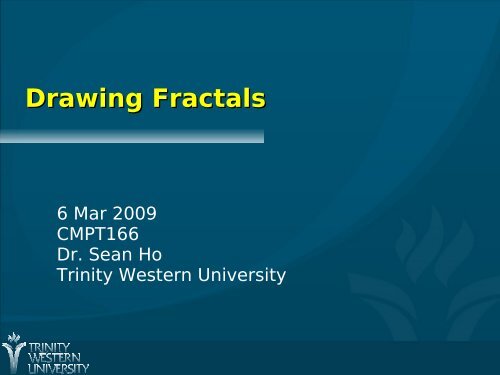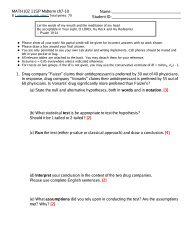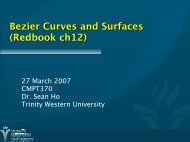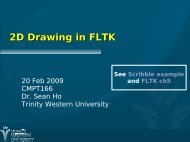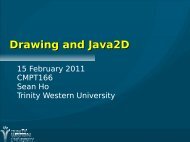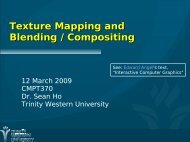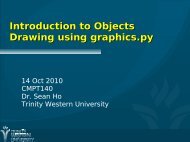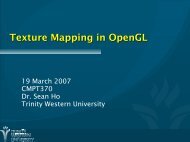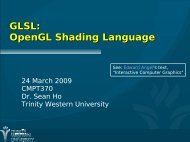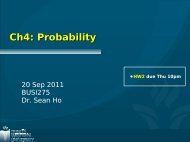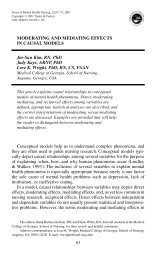Drawing Iterated Function Systems in FLTK
Drawing Iterated Function Systems in FLTK
Drawing Iterated Function Systems in FLTK
You also want an ePaper? Increase the reach of your titles
YUMPU automatically turns print PDFs into web optimized ePapers that Google loves.
<strong>Draw<strong>in</strong>g</strong> Fractals<br />
6 Mar 2009<br />
CMPT166<br />
Dr. Sean Ho<br />
Tr<strong>in</strong>ity Western University
Review last time<br />
Applications of recursion<br />
● Towers of Hanoi: algorithm<br />
● Gray codes: algorithm to generate<br />
● Fractals: self-similarity<br />
<strong>Iterated</strong> function systems<br />
Sierp<strong>in</strong>ski triangle: recursive solution<br />
Sierp<strong>in</strong>ski triangle: Chaos Game<br />
CMPT166: FractalTree example 6 Mar 2009<br />
2
Quiz 4 (10m<strong>in</strong>s, 20pts)<br />
Describe how to design/structure an <strong>FLTK</strong><br />
program that draws <strong>in</strong> a widget (like our<br />
Scribble example) [5]<br />
Name and describe at least five functions that<br />
draw <strong>FLTK</strong> “fast shapes” (we mentioned 8).<br />
Be sure to describe the parameters, too. [6]<br />
What are some limitations of the “fast shapes”?<br />
Describe what fl_push_matrix() and<br />
fl_pop_matrix() do. [5]<br />
[4]<br />
CMPT166: FractalTree example 6 Mar 2009<br />
3
Quiz 4 answers: #1<br />
Describe how to design/structure an <strong>FLTK</strong><br />
program that draws <strong>in</strong> a widget (like our<br />
Scribble example) [5]<br />
● Setup UI: create a widget to draw <strong>in</strong><br />
e.g., an Fl_Box<br />
● In the C++ tab, change the subclass to<br />
the class we are go<strong>in</strong>g to write<br />
● In C++ file, create a subclass of Fl_Box<br />
● Override the draw() method<br />
● #<strong>in</strong>clude and use the<br />
<strong>FLTK</strong> draw<strong>in</strong>g functions with<strong>in</strong> draw()<br />
CMPT166: FractalTree example 6 Mar 2009<br />
4
Quiz 4 answers: #2-3<br />
Name and describe at least five functions that<br />
draw <strong>FLTK</strong> “fast shapes” (we mentioned 8).<br />
Be sure to describe the parameters, too. [6]<br />
● fl_po<strong>in</strong>t(x,y), fl_l<strong>in</strong>e(x,y,x2,y2),<br />
fl_rect/rectf(x,y,w,h),<br />
fl_loop/polygon(x,y,x2,y2,x3,y3),<br />
fl_arc/pie(x,y,w,h,a1,a2)<br />
What are some limitations of the “fast shapes”?<br />
● No transforms<br />
● loop/polygon only up to 4 vertices, convex<br />
[4]<br />
CMPT166: FractalTree example 6 Mar 2009<br />
5
Quiz 4 answers: #4<br />
Describe what fl_push_matrix() and<br />
fl_pop_matrix() do. [5]<br />
● Transform matrices: only applies to <strong>FLTK</strong><br />
complex shapes<br />
● x,y coord<strong>in</strong>ates of objects are transformed<br />
by the matrix to f<strong>in</strong>d their f<strong>in</strong>al position<br />
on the screen<br />
● push_matrix() saves old transform so that<br />
we can change transform (scale, rotate,<br />
transform) and later restore us<strong>in</strong>g<br />
pop_matrix()<br />
CMPT166: FractalTree example 6 Mar 2009<br />
6
<strong>Draw<strong>in</strong>g</strong> IFS <strong>in</strong> <strong>FLTK</strong><br />
Some fractals like Mandelbrot set are images:<br />
● Render <strong>in</strong>to a pixel buffer (char *)<br />
<strong>Iterated</strong> function systems can be drawn us<strong>in</strong>g<br />
<strong>FLTK</strong>'s functions<br />
Transform matrices are useful!<br />
● Use complex shapes, not fast-draw ones<br />
draw triangle<br />
translate and scale smaller<br />
draw triangle<br />
recurse....<br />
CMPT166: FractalTree example 6 Mar 2009<br />
7
FractalTree example<br />
See FractalTree example<br />
Two parameters: angle and shr<strong>in</strong>k<br />
On each recursive step (see drawBranch()):<br />
● Draw left branch, then<br />
Rotate (by angle) and transl (to end)<br />
Recurse to fill out left branch<br />
Pop matrix<br />
● Draw right branch, then<br />
Rotate (by angle) and transl (to end)<br />
Recurse to fill out left branch<br />
Pop matrix<br />
Stop when branches are
<strong>FLTK</strong> event handl<strong>in</strong>g<br />
Two parameters: angle and shr<strong>in</strong>k<br />
● Use horiz mouse for angle, vert for shr<strong>in</strong>k<br />
Override the handle() method:<br />
● Takes one <strong>in</strong>t parameter: k<strong>in</strong>d of event<br />
enum type Fl_Event<br />
● Returns <strong>in</strong>t: 1 if handled, 0 if not<br />
If not handled, the event is passed on to<br />
the enclos<strong>in</strong>g widget (e.g., w<strong>in</strong>dow)<br />
● switch on the k<strong>in</strong>d of event: FL_PUSH,<br />
FL_RELEASE, FL_KEYDOWN, etc.<br />
● has full list<br />
CMPT166: FractalTree example 6 Mar 2009<br />
9
Listen<strong>in</strong>g for events<br />
We want to listen for mouse click or drag events<br />
● switch(e) {<br />
case FL_PUSH: case FL_DRAG:<br />
●<br />
●<br />
// handle this event<br />
return(1); // flag that it's taken care of<br />
For all other events that we don't care about,<br />
pass it on to the superclass to handle:<br />
● return( Fl_Box::handle() );<br />
If that doesn't take care of it, <strong>FLTK</strong> will send the<br />
event to the enclos<strong>in</strong>g widget for handl<strong>in</strong>g<br />
CMPT166: FractalTree example 6 Mar 2009<br />
10
Mouse event <strong>in</strong>fo<br />
Now that we know it's a mouse push/drag<br />
event, where are the mouse coord<strong>in</strong>ates?<br />
#<strong>in</strong>clude <br />
Fl::event_x() and Fl::event_y()<br />
Also, use Fl::event_button() to get<br />
which mouse button was pressed<br />
Fl::event_clicks() returns (# clicks)-1<br />
● So it returns “true” if double-click<br />
For FL_KEYDOWN events, Fl::event_key()<br />
returns which key was pressed<br />
● See <strong>FLTK</strong> docs ch6 for more details<br />
CMPT166: FractalTree example 6 Mar 2009<br />
11


